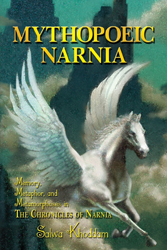Mythopoeic Narnia

Mythopoeic Narnia: Memory, Metaphor, and Metamorphosis in The Chronicles of Narnia. Salwa Khoddam. Hamden, CT: Winged Lion Press, 2011. 9781936294114. 250 pp. $16.99.
Reviewed by Katherine Sas
[This review originally appeared in Mythprint 48:11 (#352) in November 2011.]
In my junior year of college I wrote a paper contrasting the writings styles of J.R.R. Tolkien and C.S. Lewis. My basic argument was that Tolkien began creative endeavors with a word, and Lewis with an image. I wish I’d had Salwa Khoddam’s excellent new book, Mythopoeic Narnia: Memory, Metaphor, and Metamorphoses in The Chronicles of Narnia, on my shelf at the time. In an exhaustive study of Lewis’s iconographic imagery in The Chronicles of Narnia, Khoddam proves piece by piece that the concepts of memory, metaphor, metamorphoses, and are in-grained in Lewis’s theology and literary imagination, informing every part of the seven chronicles. As she writes in the introduction, “The archetypal metaphors [in the Chronicles of Narnia] form the fabric of Lewis’s chronicles, culled from his memory, to construct his plots, in order to achieve his purpose in this work: metamorphosis/thèōsis.” As Lewis’s characters experience metamorphosis, and as Lewis hoped to affect change in his readers, so Khoddam’s new work of scholarship seeks to transform the way readers approach Lewis’s Chronicles of Narnia.
After an introduction to the terms introduced in the subtitle of the book (namely: “Memory, Metaphor, and Metamorphosis”), Khoddam’s book guides the reader through the archetypal images that Lewis uses most memorably in the chronicles. These include the images of cities (both heavenly and man-made), light and sunlight, gardens, sea voyages and monsters, among others. Drawing on Lewis’s scholarship as well as his fiction, Khoddam shows how he utilized his vast store of knowledge of Biblical, Classical, and pagan traditions in writing these supposedly simple “children’s books.” Learned in these areas herself, Khoddam is able to show how Lewis combined the multifarious perceptions of each image from an array of traditions to maximize the potential for symbolic meaning to greatest effect. The best example of this is in her chapter on the image of the sea as represented in The Voyage of the Dawn Treader. Throughout the book, Lewis presents the sea in all its diversity of archetypal meaning, ranging from the medieval and Classical fear of its wildness and danger, to its positive portrayal as a source of rejuvenation, adventure, and calmed tempests as found in the New Testament and post-Renaissance travel narratives. Khoddam demonstrates how Lewis’s liberal mind was able to utilize and synthesize both poles, combining them to show the truest and deepest significance of the sea. Khoddam effortlessly spots and explains Lewis’s nuances and subtleties throughout the book.
Though I wish Mythopoeic Narnia were organized a little more clearly as it can occasionally seem a little scattered, Khoddam’s writing is lucid, readable, and easy to follow. While her scholarship is detailed and extensive, I would confidently recommend this book to readers with only the most basic knowledge of the texts she discusses. For readers whose primary exposure to these motifs and images is Lewis himself, The Chronicles of Narnia plus Mythopoeic Narnia will serve as an excellent introduction to such foundation-al writers as Spenser, Dante, Milton, and Plato, as well as to the history of Western Literature. It is not, how-ever, only valuable for beginners to literary studies. Mythopoeic Narnia, like Michael Ward’s recent Plan-et Narnia, encourages readers to look closely at Lewis’s imagery in critical interpretations of his works. This trend, which demands that Lewis’s writing hold up to in-depth critical scrutiny, will certainly contribute to The Chronicles, and Lewis’s work in general, finding the respect they deserve in literary scholar-ship. Appropriately enough for a book all about metamorphosis, Khoddam’s Mythopoeic Narnia may help to contribute to the change in readers it describes.

